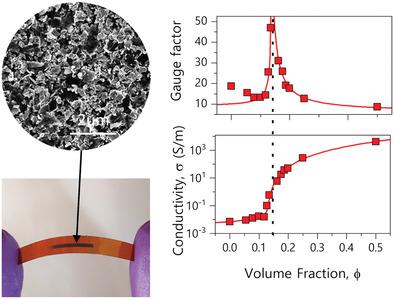当前位置:
X-MOL 学术
›
Adv. Funct. Mater.
›
论文详情
Our official English website, www.x-mol.net, welcomes your
feedback! (Note: you will need to create a separate account there.)
Tuneable Piezoresistance of Graphene-Based 2D:2D Nanocomposite Networks
Advanced Functional Materials ( IF 18.5 ) Pub Date : 2023-02-28 , DOI: 10.1002/adfm.202214855 James R. Garcia 1 , Mark McCrystal 1 , Dominik Horváth 1 , Harneet Kaur 1 , Tian Carey 1 , Jonathan N. Coleman 1
Advanced Functional Materials ( IF 18.5 ) Pub Date : 2023-02-28 , DOI: 10.1002/adfm.202214855 James R. Garcia 1 , Mark McCrystal 1 , Dominik Horváth 1 , Harneet Kaur 1 , Tian Carey 1 , Jonathan N. Coleman 1
Affiliation

|
Piezoresistive nanocomposites are an important class of materials that allow the production of very sensitive strain sensors. Herein, a new class of piezoresistive nanocomposites prepared by mixing different types of 2D nanosheets is explored. In this way, three distinct types of nanocomposite are produced by mixing conducting and insulating nanosheets (graphene, Gr and boron nitride, BN), conducting and semiconducting nanosheets (graphene and tungsten diselenide, WSe2 or tungsten disulfide, WS2) as well as mixing two different types of conducting nanosheets (graphene and silver, Ag). For each nanocomposite type, a different dependence of composite conductivity on filler volume fraction is observed although all behaviors can be fully described by percolation theory. In addition, each composite type shows different piezoresistive properties. Interestingly, while the conductor insulator composites show the standard monotonic relationship between gauge factor and conductivity, both conductor:semi-conductor and conductor:conductor composites show very unusual behavior, in each case displaying a peak engage factor at the percolation threshold. In each case, percolation theory is used to develop simple equations for gauge factor as a function of both volume fraction and conductivity that fully describes all experimental data. This work expands the understanding of piezoresistive nanocomposites and provides a platform for the engineering of high-performance strain sensors.
中文翻译:

基于石墨烯的 2D:2D 纳米复合网络的可调压阻
压阻纳米复合材料是一类重要的材料,可用于生产非常灵敏的应变传感器。在此,探索了通过混合不同类型的二维纳米片制备的一类新型压阻纳米复合材料。通过这种方式,通过混合导电和绝缘纳米片(石墨烯、Gr 和氮化硼,BN)、导电和半导体纳米片(石墨烯和二硒化钨、WSe 2 或二硫化钨、 WS 2)以及混合两种不同类型的导电纳米片(石墨烯和银,Ag)。对于每种纳米复合材料类型,观察到复合电导率对填料体积分数的不同依赖性,尽管所有行为都可以通过渗流理论进行充分描述。此外,每种复合类型都显示出不同的压阻特性。有趣的是,虽然导体绝缘体复合材料显示出应变系数和电导率之间的标准单调关系,但导体:半导体和导体:导体复合材料都表现出非常不寻常的行为,在每种情况下都在渗透阈值处显示峰值接合因子。在每种情况下,渗流理论都被用于开发作为体积分数和电导率函数的应变系数的简单方程式,该方程式充分描述了所有实验数据。
更新日期:2023-02-28
中文翻译:

基于石墨烯的 2D:2D 纳米复合网络的可调压阻
压阻纳米复合材料是一类重要的材料,可用于生产非常灵敏的应变传感器。在此,探索了通过混合不同类型的二维纳米片制备的一类新型压阻纳米复合材料。通过这种方式,通过混合导电和绝缘纳米片(石墨烯、Gr 和氮化硼,BN)、导电和半导体纳米片(石墨烯和二硒化钨、WSe 2 或二硫化钨、 WS 2)以及混合两种不同类型的导电纳米片(石墨烯和银,Ag)。对于每种纳米复合材料类型,观察到复合电导率对填料体积分数的不同依赖性,尽管所有行为都可以通过渗流理论进行充分描述。此外,每种复合类型都显示出不同的压阻特性。有趣的是,虽然导体绝缘体复合材料显示出应变系数和电导率之间的标准单调关系,但导体:半导体和导体:导体复合材料都表现出非常不寻常的行为,在每种情况下都在渗透阈值处显示峰值接合因子。在每种情况下,渗流理论都被用于开发作为体积分数和电导率函数的应变系数的简单方程式,该方程式充分描述了所有实验数据。


















































 京公网安备 11010802027423号
京公网安备 11010802027423号